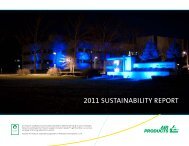Chevron Corporate Responsibility Report 2010
Chevron Corporate Responsibility Report 2010
Chevron Corporate Responsibility Report 2010
Create successful ePaper yourself
Turn your PDF publications into a flip-book with our unique Google optimized e-Paper software.
GHG Emissions<br />
In <strong>2010</strong>, our total emissions were 59.2 million metric tons of CO 2 equivalent, exceeding our goal<br />
of 59.0 million metric tons. 1 In <strong>2010</strong>, the reporting basis for total GHG emissions <strong>Chevron</strong> used<br />
was revised to exclude power generation grid credits to align with industry best practices. If the<br />
grid credits of 0.9 had been included, the net emissions of 58.3 would have achieved the goal.<br />
Our GHG emissions intensity in <strong>2010</strong> was approximately 33 metric tons of CO 2 equivalent per<br />
1,000 barrels of net oil-equivalent production from our Upstream operations, up from 32 metric<br />
tons in 2009. Our Downstream intensity was approximately 34 metric tons of CO 2 equivalent<br />
per 1,000 barrels of crude oil that was input into our refineries, down from 36 in 2009.<br />
Our preliminary goal for 2011 is 60.0 million metric tons of CO 2 equivalent. We expect to achieve<br />
further emissions reductions through energy efficiency improvements and reduced flaring<br />
and venting. We also expect normal production levels and emissions to resume in areas where<br />
disruptions occurred in <strong>2010</strong>; and we expect emissions from new facilities that will begin operation<br />
in 2011.<br />
We estimate that combustion of our products resulted in emissions of approximately 418 million<br />
metric tons of CO 2 in <strong>2010</strong>, approximately 2 percent more than the 410 million metric tons in 2009.<br />
We calculate product emissions based on total <strong>2010</strong> Upstream liquids, gas and coal production.<br />
The emissions factors used are from the American Petroleum Institute’s Compendium of<br />
Greenhouse Gas Emissions Methodologies for the Oil and Natural Gas Industry, 2 published<br />
in 2004 and revised in 2009. When compared with the International Energy Agency’s Key World<br />
Energy Statistics (<strong>2010</strong> edition), these emissions represent approximately 1.4 percent of global<br />
CO 2 emissions from fossil fuels, which is lower than the 1.7 percent of global CO 2 emissions when<br />
we first began estimating the GHG emissions from our products in 2002.<br />
Waste<br />
In 2009, we began reporting a total waste metric to track the amount of total hazardous and<br />
nonhazardous waste that is recycled (which includes reused and recovered) from our operations.<br />
In <strong>2010</strong>, total recycling was 59 percent of generated hazardous waste and 42 percent of generated<br />
nonhazardous waste.<br />
39

















